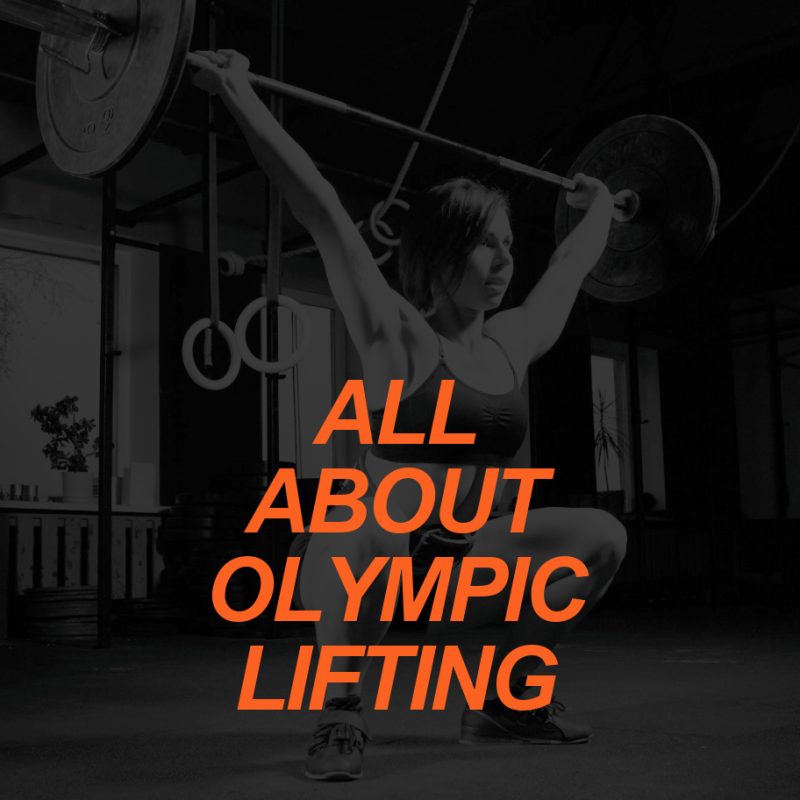
When trainers hear about Olympic weightlifting they immediately think of two things: either taking a loaded barbell and ripping it off the floor in one violent motion with minimal technique, or that the lifts are detrimental and deleterious to the health and well being of the person doing the lifts. These two assumptions highlight a vast miscomprehension of Olympic weightlifting.
To begin, Olympic weightlifting athletes have incredible skill and incredible mobility. The elite lifters in the sport are capable of lifting double to three times their bodyweight overhead. In the 2012 Olympic Games in London, a 56 kilogram (123 pounds) lifter successfully lifted 168 kilograms (370 pounds) overhead. Much of their ability, aside genetics, can be attributed alone to simply performing the lifts. The development of these athletes displays 40-yard dash times and vertical jumps that would make an athlete in any professional sport jealous. And, in fact, Olympic weightlifting is one of the main tenets of program design for professional athletes due to the developmental gains this style invokes.
Currently, there are two major issues with incorporating Olympic weightlifting into training programs. The first being that most training programs today are based on body building style of programming or so called “functional training”, and often shy away from incorporating Olympic lifting upon the dogma that it would be harmful to their trainee. Many are correct in this sense, but this is mainly because most trainers are unaware of how to properly utilize the lifts, and add weight too quickly. Experienced trainers can take the movements and integrate them in a program to allow for improvements in flexibility, motor control, and ameliorate force generation. In fact, using the lifts, and their many variations, to increase mobility will improve any athlete’s performance no matter what age or level. In order to perform the lifts at any level of efficiency, hip, shoulders and thoracic spine flexibility is greatly required. If a trainee’s flexibility in any or all of these areas is poor, variations of the lifts can improve the ability of individuals to perform by greatly enhancing range of motion and mobility.
The other major issue with Olympic lifting is trainers do not understand how to properly instruct the lifts, and then implement them incorrectly by performing high repetitions. Any Olympic movement is supposed to be done fast and explosively to develop immediate force production of the fast-twitch fibers. Trainers have been misusing the Olympic lifts by doing 10-12 reps or greater, or multiple max-effort attempts done between other exercises. The correct way to do this is not more than 3 repetitions. Whenever these complex movements are done for anything greater than 3 reps, and with even moderate weight, a degradation of performance occurs and can result in injury due to joint instability or development of faulty movement patterns as the body fatigues and compensates.
How to Properly Perform the Lifts
While the lifts themselves seem complex, they are in actuality very simple in terms of human movement. Essentially, all that makes a successful lift is a rapid stand, then sit. One of the most difficult portions of the clean lift, for example, is the “sit-under”. The sit-under is just another portion of the movement in the kinetic chain; its effectiveness is contingent upon the other phases of the clean being performed correctly in space and time.
While the focus of this post is on a single phase of the clean, a brief summarization of all phases of the lift below is to provide context to our discussion. The clean can be divided into five phases:
1. The Start Position: The athlete positions and sets the body in relation to the bar.
2. First Pull: The athlete breaks the inertia of the bar and brings the body/bar into position for the second pull.
3. The Second Pull: With the barbell above the knees, the athlete applies maximum force to accelerate to the bar.
4. The Sit-Under: The athlete descends to receive the bar on the shoulder.
5. The Recovery: From the receive position, the athlete stands.
To perform the Sit-Under correctly, the athlete must also be proficient with the other phases outlined above. If not, they must continue to practice in order to execute properly.
A common cue used by instructors when performing the snatch, clean, or accessory pulls to those lifts is to pull the barbell as high as you can or to shrug hard. These cues become detrimental to the instruction of the lift by instilling poor physical characteristics in the lifter. When the focus shifts to the shrug the athlete becomes upper-body centered, meaning that the major concentration of the second pull is focused on violent elevation of the shoulders, and the consequence of such deliberate emphasis will direct the forces/energy of the athlete into the upper body which will dissociate it from the lower body. Any non-directional (extraneous) forces from the lifter will interfere with the path and speed of the bar. If one purposely tries to shrug longer or harder, either the path of the bar or trajectory of the lift will be affected, as well as reducing the chances of having an effective sit-under.
Directing the energy away from a total body movement will harm the lift in the following ways:
1. Too much time is spent/wasted in the shrugging phase – this causes the arms to stiffen or be too stiff. This will disturb the path or the trajectory of the bar away from the body.
2. As an upper body puller, you can also have too much head and upper body extension which will affect the trajectory of the bar away from the body.
3. When the path of the bar is disturbed, many individuals try to compensate by pulling more with the arms.
All of the above faults will decrease the effectiveness of the sit-under. Here is what to do:
1. Do not shrug the bar; you want to be sure to stay relaxed yet still have tension and stretch in the trapezius.
2. Using the legs, there needs to be more “push” from the lower body. If coaches use the lifts to train explosiveness, use the hips!
3. When done correctly the push will keep the bar close to the body, allowing the athlete to sit under comfortably instead of pulling the bar back into the body. If the clean is performed properly, the athlete will generate the great force necessary to break the inertia of the bar from the floor and maintain a bar path as close to the body as possible.
As the speed of the bar increases in the first pull and is accelerated in the second pull, performer and apparatus becomes one. If a clean is performed properly, the shrug is an extension of the momentum of this body/barbell unit.
The Athlete and the “Hang”
For athletes, the Olympic lifts are an outstanding means to achieve better performance for sport. Many coaches emphasize the “hang” variations of the lift as most beneficial for their athletes to perform in the weight-room. The main idea behind performing either of the Olympic lifts from the hang is that it focuses directly on improving the athlete’s hip power. The hang is in and of itself the second-pull portion of the lifts, and is where the greatest velocity is produced. Olympic weightlifting athletes train with variations of the pull to improve their overall efficacy of performing the lift, however, not exclusively. For athletes in any sport, it is practical and beneficial to perform the lifts in a variety of positions, whether it is hang or full versions. A good coach will incorporate many variations of the lifts into an athlete’s programs so that the athlete can make the most gains, but performing the lifts from the hang position, while improving hip drive, works a short range of body position. The greater ranges of motion and positions that can be worked and trained will allow for more rounded development of the athlete by strengthening the body to overcome external forces through the entire range of motion. The knowledge and technical background of the coach is ultimately what will determine whether the athlete can properly perform the lift from any position.
Variations as Corrective Exercises
Above described what proper execution of a lift should consist of, and cues that can be utilized when coaching and understanding how the lift needs to be executed. Many coaches attempt to instruct the lifts, however, without actual experience performing the lifts directly inhibits the coach’s ability to accurately identify and instruct. This is pertinent to having an individual perform the lifts within a program because there needs to be an understanding of correct body position through “feel”. At this point, will the coach be able to convey proper position, and identify limitations in mobility?
Not everyone is capable of performing the correct body position to properly execute the lifts. When this occurs, there are variant exercises that trainers and coaches can utilize which can help to improve posture, mobility, and strength. Whether it be preparing an athlete to perform full versions of the lifts, or a recreational trainee looking to increase mobility and mitigate joint pain.
The most common problem associated with the correct lift position, with which variant correctives seek to ameliorate, is increasing the mobility of the thoracic spine, shoulder girdle, and hip. The following exercises are useful in developing the needed mobility and motor control to progress towards the full lifts:
Thoracic Stretch:
Mobility of the upper back, or Thoracic spine, is paramount for Olympic weightlifting. If an athlete cannot properly position their upper-back, the position of the body throughout the lift will never be in its most effective position to transfer forces and support heavy loads overhead. The following stretch will allow athletes to develop the needed mobility in this region to assist in proper form.
1. Approaching a high box or table, have the athlete kneel down and place hands on the mass in a snatch grip.
2. Keeping the arms fully locked, and head neutral, instruct the athlete reach their sternum down to the floor. There may be a stretch in the chest and shoulder area, but mainly the upper back region should be experiencing a stretch.
3. Have the athlete hold the depressed position for 3-5 seconds, rise slightly, and repeat.
Seated wide-grip presses:
This exercise is particularly useful for those who have limited shoulder and upper-back mobility. This exercise forces the individual through a range of motion that they need to improve by stretching and activating the musculature of the areas.
Similar to overhead squats, seated wide-grip presses aid in the development of thoracic mobility in a more difficult position for the athlete; that position being in a descended squat and necessitating greater extension of the upper back so as to maintain a more erect torso while bearing weight overhead.
1. Have the athlete address a dowel or barbell with a snatch grip.
2. Holding overhead in a locked position, the athlete will then sit to a designated height maintaining the correct back angle. The height is based upon mobility of athlete.
3. Once seated, the athlete will lower the apparatus down to the top of the shoulders and then press up, while forcing the upper back to maintain position.
4. The athlete will then stand and repeat.
Prisoner squat in front of wall:
Even many high-level athletes have difficulty correctly performing full squats. The main issue that arises is limited mobility in the hips. The limited ranges tend to develop the body differently by altering the muscular activation patterns of this region.
1. Instruct the athlete to face a wall with the toes approximately 3-6 inches away and turned slightly outwards.
2. Have both hands positioned behind the head as if relaxing in an armchair.
3. From this point, have the athlete sit as low as they can without a break in technical position or touching the wall with any portion of the body. As the athlete descends, mechanical faults will begin to manifest. It is the duty of the coach to instruct the athlete on the proper depth, position of the legs, and erectness of the torso. Forcing the body into position and holding will give the athlete a sense of proper body position as well as open up tight areas.
4. Recover from the bottom position.
Wrap Up
Utilizing the instruction methods above, one can help develop their Olympic weightlifting technique. It is always important, however, to have a highly-knowledgeable coach to provide instruction, and monitor the athlete through training. For those training on their own, keep the information above in mind when training, and incorporate the above stretching regimen during pre-lifting warm-ups to ensure that the body has the mobility to begin to conduct the lifts.
References
1. Arabatzi, F., and Kellis, E., (2009) Biomechanical Analysis of Snatch Movement and Vertical Jump: Similarities and Differences. Hellenic Journal of Physical Education & Sport Science, 29(2): 185-199.
2. Enoka, R. M. (1988) Load- and skill-related changes in segmental contributions to a weightlifting movement. Medical Science and Sports Exercise., Vol. 20, No. 2, pp. 178-187.
3. Gregoire, L., Veeger, HE., Huijing, PA., van Ingen Schenau, GJ. (1985) Role of mono- and biarticular muscles in explosive movements. International Journal of Sports Medicine. 5(6):301-5.
4. Kipp, K, Harris, C, and Sabick, MB. (2011) Lower extremity biomechanics during weightlifting exercise vary across joint and load. Journal of Strength Conditioning Research. 25(5): 1229-1234.
5. Kipp, K., Redden, J., Sabick, M., Harris, C. (2010) KINEMATIC AND KINETIC PATTERNS IN OLYMPIC WEIGHTLIFTING Conference Proceedings Archive, 28 International Conference on Biomechanics in Sports.
6. Kipp, K., Redden, J., Sabick, M., Harris, C. (2011) Kinematic and Kinetic Synergies of The Lower Extremities During the Pull in Olympic Weightlifting. Journal of Applied Biomechanics Oct 4. [Epub. ahead of print] (Abstract only).
7. Moon, YJ. Performance Enhanced Model in Snatch Weightlifting- Using the kinematic factors. Korean Journal of sport Biomechanics. 2005, Vol. 15(2), 20-30
8. Schilling, B., Stone, M., O’Bryant, H., Fry, A., Coglianese, R., and Pierce, K. (2002) Snatch Technique of Collegiate National Level Weightlifters. Journal of Strength and Conditioning Research. 16(4), 551-555.
9. van Ingen Schenau, G., Bobbert, M., and Rozendal, R., (1987) The unique action of bi-articular muscles in complex movements. Journal of Anatomy. 155: 1–5.
10. Xeuling, B., Hongsheng, W., Xi’an Z., Wenting, J., and Chengtao, W., (2008) Three-dimension kinematics simulation and biomechanics analysis of snatch technique. Proceedings of 1st Joint International Pre-Olympic Conference of Sports Science & Sports Engineering. Vol. 1: Computer Science in Sports. Nanjing, P. R. China, August 5-7, 291-296.
11. Ho, KWL., Williams, MD., Wilson, CJ., and Meehan, DL., (2011) Using Three-Dimensional Kinematics to Identify Feedback for The Snatch: A Case Study. Journal of Strength Conditioning Research. 25(10): 2773-2780






